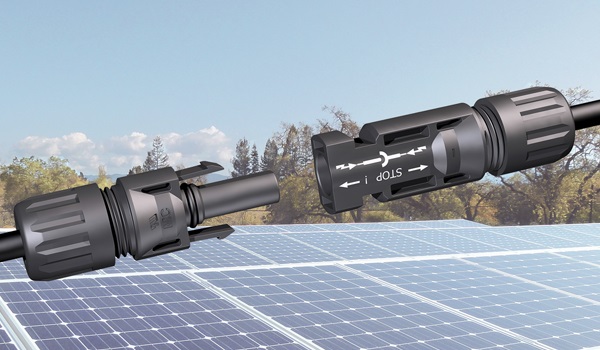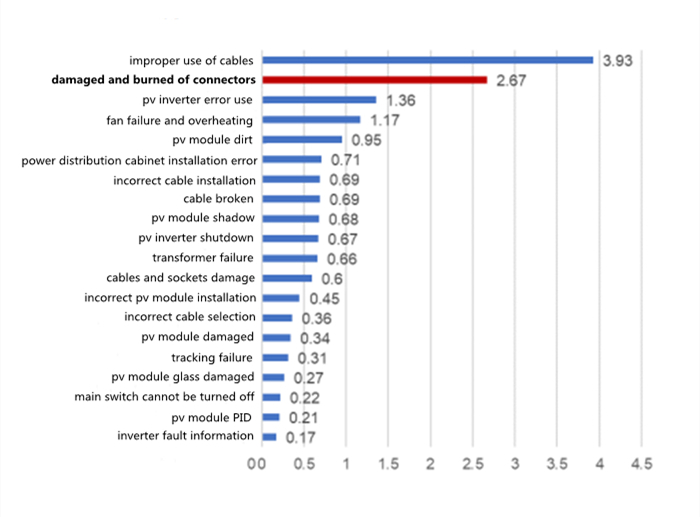PV DC Connectors Not To Be Ignored In Solar Photovoltaic Station
With the support of various policies, the construction of photovoltaic power plants is in full swing, and safety issues are the top priority. The report shows that in the loss of power generation revenue caused by the risk of failure of the TOP20 technology of the power station, the damage and burning of the PV DC connector ranked second.
In the context of achieving the “dual carbon goal”, it is estimated that in the next five years, my country’s annual new photovoltaic installed capacity will reach 62 to 68 GW, and China’s cumulative installed capacity of photovoltaic power stations will reach 561 GW in 2025.
It is foreseeable that whether it is a ground power station or a distributed power station, the installed capacity of photovoltaic will enter a stage of large-scale growth, but there are more and more safety issues that come with it, which has attracted the attention of the industry.
Safety is the lifeblood of photovoltaic power plants, and it is also the foundation for obtaining return on investment. Regardless of the scenes of photovoltaic power plants on the ground, on the mountain, on the roof, etc., safety is a matter of principle.

Three Hidden Dangers in Photovoltaic Power Plants
There are three main reasons for the accident problem of photovoltaic power station:
First, the solar panel PV DC connector, commonly known as the MC4 connector. When the power of the PV moudles becomes larger and larger, the current will increase accordingly. In this case, the solar panel connector heats up more and more, which creates a fire hazard. Therefore, the connector is one of the most fire-prone points in the DC side link of the module.
Second, the PV DC combiner box. In the DC combiner box, there are densely arranged lines and electrical appliances, plus a closed metal box. In a sealed structure environment, the heat of the electrical appliances and the connection points in the box will be relatively high, and it is not easy to dissipate heat. In the case of long-term operation Under the circumstances, problems such as heating and tripping of electrical appliances are prone to become hidden dangers of fire.
Third, medium and high voltage cable joints. In power stations, 35 kV medium voltage electrical systems and 110kV/220kV high voltage boost systems are common. The voltage level of medium and high voltage products is relatively high. Cable accessory products are prone to partial discharge and breakdown problems. Therefore, this is also photovoltaic One of the hidden dangers of power station accidents.
In the PV Power Station Top 20 Technical Failure, the PV DC Connector Ranked Second
It can be seen from the analysis of the above three reasons that the potential safety hazards brought by the PV DC connector cannot be ignored! Otherwise, accidents such as connector fire, burnout, PV junction box failure, component leakage, and power failure of the components of the string will occur later.
According to a report released by the “Solar Bankability” project team of the European Union’s Horizon 2020 plan, connector damage and burnout rank second in the loss of power generation revenue caused by the risk of power station TOP 20 technical failure.

Loss of power generation revenue caused by the risk of photovoltaic power station top 20 technology failure
Why are PV DC Connectors So Important?
1. Use a lot of quantity. In photovoltaic systems, connectors are used from solar panels, inverters to the project site. A 1MW photovoltaic system will probably use 2000 to 3000 sets of PV DC connectors according to the power of the modules used.
2. The potential risk is high. Each set of PV DC connectors contains 3 risk points (connection parts, positive and negative terminals and cable crimping parts), which means that in a 1MW system, the connector may bring 6000 to 9000 risk points. In the case of current flow, the increase in the contact resistance of the connector will lead to an increase in temperature rise. If it exceeds the temperature range that the plastic shell and metal parts can withstand, the connector is very easy to fail or even cause a fire.
3. Difficulty in on-site operation and maintenance. Most of the existing monitoring software can only monitor to the string level. For specific faults in the string, on-site troubleshooting is still required. This means that if there is a problem with the MC4 connector, it must be checked one by one. For industrial and commercial power stations (color steel tile roofs), operation and maintenance are more difficult. Workers need to climb on the roof and then manually open the solar panels, which is time-consuming and laborious.
4. Large power consumption. The PV connector itself does not produce energy, it is a transmitter of energy. In the process of energy transmission, there is bound to be loss. If calculated by the average contact resistance of the connectors on the market, a 50MW power station will consume approximately 2.12 million kWh of electricity due to the connectors during the 25-year operation period.
Driven by policies this year, the construction of photovoltaic power plants is in full swing, and the goal of carbon neutrality and carbon peaking can be expected, but the prerequisite for all this must be safety. Photovoltaic connector companies also need to propose innovative solutions to the problem of safety, so as to reduce the occurrence of safety accidents during the operation of photovoltaic power stations, and to make our road to carbon neutrality more stable and practical.
